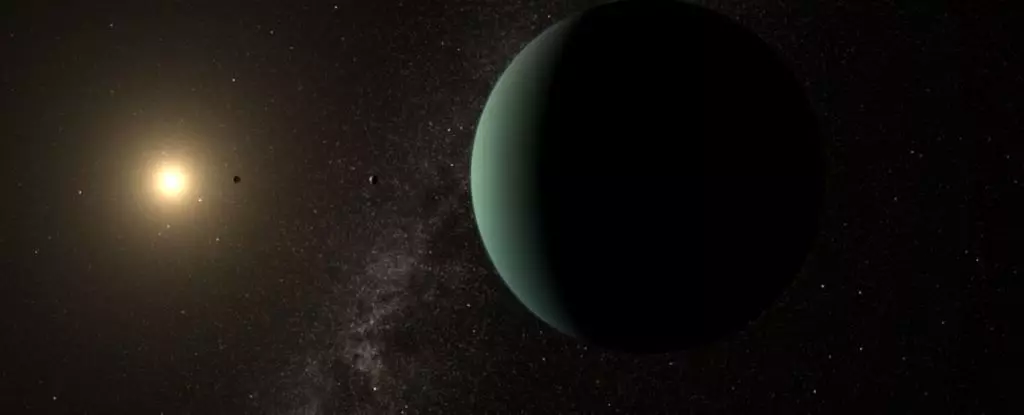As astronomers continue their quest to identify extraterrestrial life, recent findings regarding an exoplanet located just 20 light-years away from our Solar System have sparked excitement. The exoplanet, designated HD 20794 d, appears to hold some of the essential characteristics that could support life as we understand it. While its discovery is a promising development, it raises critical questions about the nature of habitability in the universe and what we can learn from this nearby celestial body.
HD 20794 d is intriguing not just because of its proximity to Earth but also due to its mass, which is nearly six times that of our planet. Orbiting a Sun-like star, this newly identified world resides in a location that could allow liquid water to exist on its surface—an essential requirement for life as we know it. The concept of the habitable zone, defined as the specific distance from a star where temperatures can support liquid water, plays a crucial role in assessing the planet’s potential for habitability.
The exoplanet orbits a yellow dwarf star, sharing similarities with our Sun. However, nuances such as its slightly smaller size and advanced age suggest that while it continues to fuse hydrogen, it has matured enough for its planets to stabilize. This stability is a promising sign, hinting that conditions might be ripe for the emergence of life in this alien system.
The journey to confirm HD 20794 d’s existence was filled with scientific rigor and persistence. Initial detection efforts in 2011 yielded the discovery of three exoplanets orbiting the host star, yet extracting more detailed information remained elusive. A significant breakthrough occurred in 2022 when astrophysicist Michael Cretignier observed periodic fluctuations in the star’s spectrum, suggesting the gravitational pull of an unseen planet.
The subtlety of the signals necessitated meticulous data analysis. Through collaboration and advanced observational techniques using the European Southern Observatory’s ESPRESSO instrument, researchers were finally able to affirm the presence of HD 20794 d. The collaborative nature of this research exemplifies the dedication required in modern astronomy to confirm such celestial phenomena.
Understanding the specifics of where HD 20794 d lies in relation to its star is crucial. The planet’s orbit, reportedly 648 days, places it within the star’s habitable zone. However, important caveats exist. The elliptical nature of its orbit means the planet experiences variations in distance from its star, swinging from warm, potentially water-friendly zones to areas where temperatures plummet significantly, freezing any liquid water present.
This nuanced journey through the habitable zone invites visualization of the environment HD 20794 d might offer at different points in its orbit. Part of its path allows liquid water to exist, but this becomes complicated during the colder, distant phases. Understanding these orbital dynamics is fundamental to evaluating the true likelihood of habitability on HD 20794 d.
Despite the promising factors surrounding HD 20794 d, uncertainties remain regarding its exact composition and characteristics. As there is no definitive information on the exoplanet’s radius, scientists are unable to accurately calculate its density. This lack of crucial data raises the critical question: is HD 20794 d a rocky, terrestrial-like planet similar to Earth, or could it be a larger, gaseous body akin to a mini-Neptune?
The implications of its composition have significant ramifications for its habitability potential. A rocky, terrestrial planet could potentially support life, while a gaseous exoplanet might not provide the necessary conditions. Therefore, ongoing observations and studies will be essential to unravel the nature of this tantalizing world just beyond our cosmic doorstep.
In light of these discoveries, the excitement surrounding exoplanet HD 20794 d reflects the broader quest for knowledge regarding life beyond Earth. Its proximity offers a unique opportunity for future space missions aimed at acquiring images and deeper insights into its properties. The potential existence of a habitable world so near to us not only fuels scientific curiosity but also embodies a profound hope for understanding life’s existence throughout the universe.
As researchers continue to scrutinize this newfound exoplanet, the quest for life and our place within the cosmos becomes ever more vibrant. HD 20794 d represents a critical juncture in astrophysics and astrobiology, prompting deeper inquiries into the very essence of habitability and expanding our horizons in the search for extraterrestrial life. With continued advancements in technology and collaboration, we may soon uncover more about this intriguing planet, reshaping our understanding of life beyond Earth.

